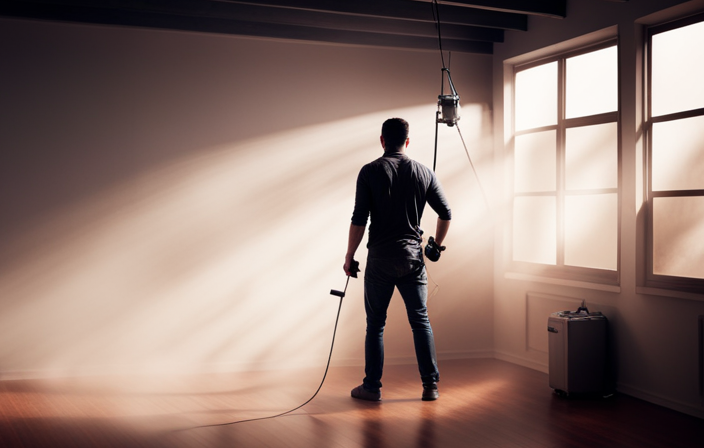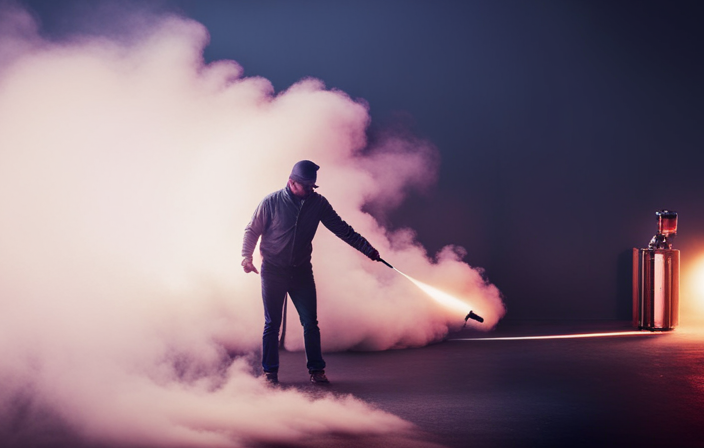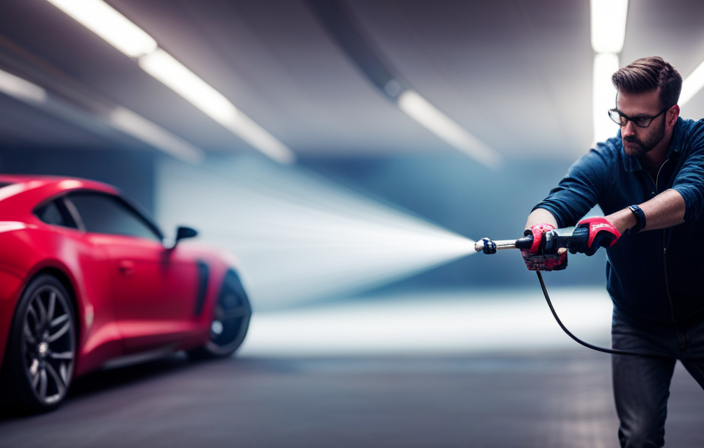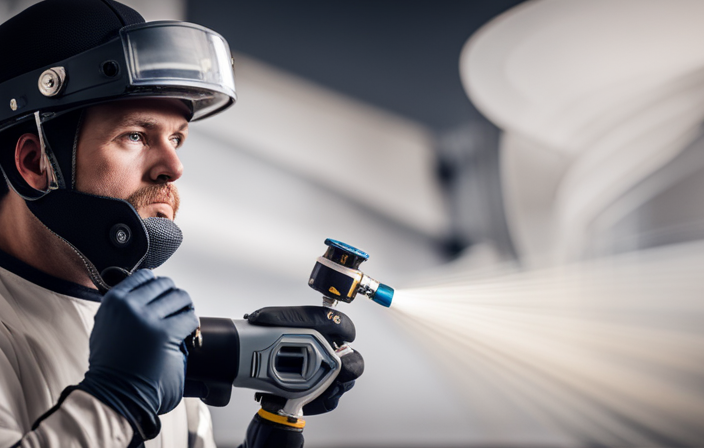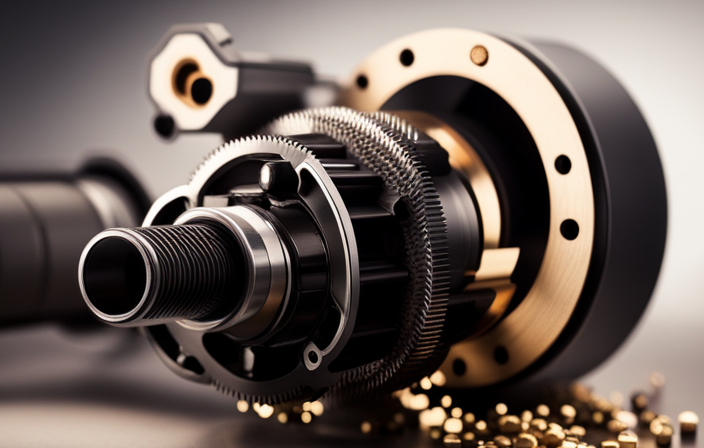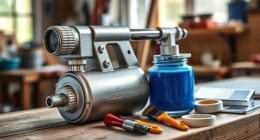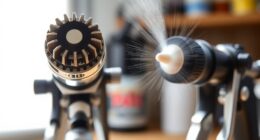You may be under the impression that painting the inside of a house seems like a daunting task. But, I’m here to assure you that it doesn’t have to be difficult. By using the right tools and techniques, the job can be made easier. This is where having an airless sprayer comes in handy.
In this article, I’m going to show you how to paint inside your house using an airless sprayer, step by step.
First, we’ll talk about preparing the room for painting, making sure everything is protected and ready to go. Then, we’ll gather the necessary materials and practice proper safety measures to ensure a smooth and accident-free process.
Next, we’ll discuss how to prepare the paint and the sprayer for optimal results.
Once everything is set up, we’ll dive into the actual painting process, covering techniques and tips to achieve a professional finish.
After that, we’ll go over the clean-up process and how to properly care for your sprayer.
Finally, we’ll talk about allowing the paint to dry, inspecting the results, and enjoying your newly painted space.
So, let’s get started and transform your home with the power of an airless sprayer!
Key Takeaways
- Benefits of using an airless sprayer for painting the inside of a house include easier and more efficient painting.
- Room preparation involves moving furniture to the center, covering it with plastic or sheets, and laying down drop cloths on the floor for protection.
- Choosing the right equipment and paint is important, such as selecting a high-quality sprayer with adjustable settings and choosing a paint color that suits preferences and the room’s design.
- Safety precautions should be taken, such as wearing protective clothing and eyewear and ensuring proper ventilation in the room.
Prepare the Room for Painting
Now it’s time for me to get the room ready for painting. I’ll grab my drop cloths and start protecting my furniture and floors!
First, I’ll carefully move all the furniture to the center of the room and cover it with plastic or old sheets to prevent any paint splatters.
Next, I’ll lay down drop cloths on the floor to protect it from any accidental drips or spills.
Once the room is properly protected, I’ll inspect the walls for any imperfections or holes. I’ll use spackling paste to patch up any cracks or dents, and sand them down once they’re dry. This will ensure a smooth and even surface for the paint.
Now that the room is prepped and the walls are patched, it’s time to gather my painting materials.
Gather Your Materials
First, you’ll need to round up all the necessary supplies for the job. Here is a helpful table to guide you in gathering your materials:
| Supplies | Description |
|---|---|
| Airless sprayer | Choose a high-quality sprayer with adjustable settings for different surfaces. |
| Paint | Select a paint color that suits your preferences and the room’s design. Consider using a low-VOC paint for a healthier environment. |
| Paint filters | These ensure a smooth and clog-free spray by removing impurities from the paint. |
| Drop cloths | Protect your floors and furniture from paint spills and splatters. |
When choosing the right paint color, consider the room’s lighting and existing decor. Take advantage of sample pots to test colors on the walls before committing. To achieve a smooth finish, ensure the paint is properly mixed and strain it through a filter. Apply thin and even coats, moving the sprayer in a steady motion. Finally, practice proper safety measures, such as wearing protective goggles and a respirator, to prevent any accidents or health risks.
Transition: Now that you have gathered all the necessary materials, it’s important to practice proper safety measures to ensure a successful and safe painting experience.
Practice Proper Safety Measures
When it comes to painting inside a house with an airless sprayer, it’s important to practice proper safety measures.
I always make sure to wear protective clothing and eyewear to shield myself from any potential splatters or fumes.
Additionally, ensuring proper ventilation in the room is crucial to prevent the buildup of hazardous paint fumes.
Lastly, I handle and operate the sprayer with caution to avoid any accidents or injuries.
By following these key points, I can ensure a safe and successful painting experience.
Wear protective clothing and eyewear
To keep yourself safe and avoid any paint splatters, make sure you’re wearing protective clothing and eyewear while painting inside your house with an airless sprayer. Wearing protective clothing and eyewear is crucial during painting because it provides a barrier between the paint and your skin, preventing any potential allergic reactions or skin irritations.
Additionally, it safeguards your eyes from paint particles that may cause serious eye injuries. When choosing protective clothing, opt for long-sleeved shirts, long pants, and closed-toe shoes to minimize skin exposure. For eyewear, select safety goggles that fit snugly and have side shields to protect your eyes from any paint drips or splatters.
By wearing the appropriate protective clothing and eyewear, you can ensure a safer painting experience.
Now, let’s move on to the next section and discuss how to ensure proper ventilation in the room.
Ensure proper ventilation in the room
Make sure you’re aware that proper ventilation is essential when painting indoors, as studies have shown that poor air quality can lead to respiratory issues and even long-term health problems.
When using an airless sprayer to paint inside a house, it’s important to ensure that there’s adequate fresh air circulation in the room. Proper ventilation benefits you by reducing the inhalation of paint fumes and harmful volatile organic compounds (VOCs).
Open windows and doors to create cross ventilation, and consider using fans to help circulate the air. Additionally, wearing a mask can provide an extra layer of protection.
By allowing fresh air to flow into the room, you can minimize the risk of breathing in harmful chemicals and maintain a healthier environment.
Now, let’s move on to the next section about using caution when handling and operating the sprayer.
Use caution when handling and operating the sprayer
Be cautious and operate the sprayer with care to ensure your safety. When handling the airless sprayer, it’s important to take certain precautions.
First, always wear protective goggles and gloves to shield yourself from potential paint splatter.
Second, maintain a firm grip on the sprayer, keeping it steady while spraying to achieve a smooth and even coat.
Lastly, be mindful of the sprayer’s nozzle, as it can create a powerful spray that may cause injury if mishandled.
In terms of sprayer maintenance, regularly clean the sprayer after each use to prevent clogs and ensure optimal performance. Additionally, check the sprayer’s filters and replace them as needed.
With these handling precautions and proper sprayer maintenance, you can safely and effectively paint your walls.
Now, let’s move on to preparing the paint and sprayer.
Prepare the Paint and Sprayer
Grab your paint cans and sprayer, and get ready to transform your space into a masterpiece! Before you begin painting with an airless sprayer, it’s important to properly prepare both the paint and the sprayer.
Start by selecting the paint color that matches your desired aesthetic. Make sure to choose a paint that’s compatible with your sprayer, as different sprayers may require specific types of paint.
Once you have your paint ready, pour it into the sprayer’s container, following the manufacturer’s instructions. Ensure that the sprayer is clean and free from any debris or paint residue. This will help prevent clogs and ensure an even paint application.
With your paint and sprayer prepared, you’re now ready to start painting and bring your vision to life!
Start Painting
Now it’s time to unleash your inner artist and start adding vibrant color to your space with the help of your trusty sprayer.
To achieve a smooth and professional finish, there are a few techniques you should keep in mind when starting to paint. First, make sure you have the right nozzle size for the paint you’re using. A smaller nozzle is ideal for fine detail work, while a larger one is better for larger areas.
Next, hold the sprayer about 12 inches away from the surface and move it in a steady, sweeping motion. This’ll help to avoid drips and uneven coverage.
Finally, remember to overlap each stroke slightly to ensure an even application. As you start painting, pay attention to detail and focus on creating a flawless finish.
Pay Attention to Detail
When it comes to paying attention to detail while painting, I always make sure to use a brush or roller for corners and edges. This allows for precise application and ensures that every nook and cranny is covered with paint.
Additionally, I carefully check for any missed spots or drips, as these can be easily overlooked but can ruin the overall finish of the paint job.
Lastly, I make it a point to touch up as needed before the paint dries, as this allows for a seamless and flawless final result.
Use a brush or roller for corners and edges
Utilize a brush or roller to expertly address corners and edges when painting inside a house with an airless sprayer. This technique ensures that every nook and cranny is covered with precision, resulting in a flawless finish. Here are some key points to keep in mind when using a brush or roller for corners and edges:
- Use a high-quality brush with fine bristles for better control and smoother application.
- Apply a small amount of paint on the brush or roller to avoid drips and excess paint.
- Hold the brush or roller at a slight angle to reach tight corners and edges effectively.
- Use smooth and even strokes to blend the painted areas seamlessly with the rest of the wall.
- Clean the brush or roller properly after each use to maintain its condition.
By paying attention to these brush techniques and roller applications, you can achieve a professional-looking paint job.
Now, let’s move on to the next step and check for any missed spots or drips.
Check for any missed spots or drips
After completing the brush and roller technique for corners and edges, it’s essential to thoroughly inspect the painted surface for any overlooked areas or drips. This step is crucial to ensure a flawless finish.
I recommend taking a step back and examining the entire room from different angles to identify any missed spots. Look for areas where the paint may not have fully covered the surface or where there are visible brush strokes.
Additionally, check for any paint drips that may have occurred during the application process. These can often be found on the floor, baseboards, or furniture. It’s important to address these issues before the paint dries to avoid having to do touch-ups later on.
So, take your time and make sure everything looks perfect.
Touch up as needed before the paint dries
Before the paint dries, be sure to fix any imperfections or touch up areas that may need a little extra attention. Here are four touch up techniques to prevent paint drips:
-
Feathering: Use a dry brush to blend the touch up area with the surrounding painted surface. This technique helps create a seamless finish.
-
Dabbing: If there are small missed spots, gently dab the paint onto those areas using a small brush or sponge. This method ensures even coverage.
-
Sanding: Smooth out any rough patches or drips by lightly sanding the surface. Be careful not to sand too much and damage the underlying paint.
-
Blotting: If you notice any excess paint or drips, quickly blot them with a clean cloth or paper towel. This’ll help remove the excess paint before it dries.
Once you’ve completed the touch ups, you can move on to the next section about clean up, ensuring a professional-looking paint job.
Clean Up
When you’re done painting with the airless sprayer, the next step is to tackle the clean-up process. This is an important part of the painting job as it ensures that your equipment is properly maintained and ready for future use.
Start by cleaning the sprayer thoroughly, following the manufacturer’s instructions. Remove any excess paint from the machine and unclog the nozzle if necessary. Dispose of any unused paint properly, according to local regulations. You can either store it for future use or take it to a hazardous waste facility.
Once the sprayer is clean, wipe down any surfaces that may have been splattered with paint and gather all the tools and materials used.
With the clean-up complete, you can now move on to allowing the paint to dry.
Allow the Paint to Dry
When allowing the paint to dry, it’s important to follow the recommended drying time provided by the manufacturer. This will ensure that the paint fully sets and adheres to the walls.
Additionally, it’s crucial to keep the room well-ventilated during the drying process to help speed up the drying time and prevent any strong fumes from lingering.
Lastly, it’s essential to avoid touching or placing objects against the freshly painted walls to prevent smudges or damage to the paint job.
Follow the recommended drying time for the paint
Once the paint has been applied with the airless sprayer, it’s crucial to adhere to the recommended drying time. This allows the colors to harmonize and dance across the walls like a perfectly choreographed ballet. Different paint brands have different drying times, so it’s important to follow the instructions provided by the manufacturer.
Some recommended paint brands include Sherwin-Williams, Behr, and Benjamin Moore. To achieve a smooth finish, it’s recommended to apply multiple thin coats rather than one thick coat. This helps prevent drips and ensures an even coverage. Additionally, make sure to use a high-quality paintbrush or roller for touch-ups or hard-to-reach areas.
Remember, patience is key during the drying process, as rushing it may result in an uneven finish. Keeping the room well-ventilated during the drying process is essential for proper curing and to prevent any potential odors.
Keep the room well-ventilated during the drying process
After following the recommended drying time for the paint, it’s crucial to keep the room well-ventilated during the drying process. This step is often underestimated but plays a vital role in achieving a flawless finish.
Proper ventilation helps the paint dry evenly and prevents any unwanted odors or fumes from lingering in the room. To ensure adequate ventilation, open windows and doors to allow fresh air to circulate. Using fans or air purifiers can also expedite the drying process by increasing air movement.
Remember, the drying techniques used can greatly impact the overall quality of the paint job. Now, let’s move on to the next section and learn how to avoid touching or placing objects against the freshly painted walls.
Avoid touching or placing objects against the freshly painted walls
To ensure a flawless finish, remember to resist the temptation to touch or lean objects against your newly painted walls. Avoiding wall damage and preventing paint smudges is crucial during the drying process.
Even though the paint may feel dry to the touch, it’s still curing and can easily be damaged. Be mindful of any furniture, decorations, or other items that may come into contact with the walls. Avoid leaning ladders, chairs, or anything that could potentially leave marks or smudges.
Additionally, refrain from touching the walls with your hands or fingers. It’s best to give the paint ample time to fully dry and cure before interacting with the walls in any way.
Once you’ve taken these precautions, you can move on to inspecting the results and ensuring a professional-looking paint job.
Inspect the Results
After allowing the paint to dry, it’s important to inspect the results to ensure a flawless finish. I carefully checked for any imperfections or areas that may need touch-ups, such as streaks or uneven coverage.
Additionally, I assessed the overall appearance and quality of the paint job, making sure it met my expectations. If I found any issues, I immediately made the necessary corrections or improvements to achieve a professional-looking outcome.
Check for any imperfections or areas that may need touch-ups
First things first, take a good look around for any sneaky imperfections or spots that might need a little extra love – you don’t want any surprises later on!
Identifying touch-up areas is crucial to achieving a flawless finish. Grab a flashlight and inspect the walls for any drips, streaks, or areas where the paint might have pooled. Pay close attention to corners, edges, and trim, as these are common trouble spots.
Fixing imperfections is as simple as gently sanding down any rough patches and applying a thin coat of paint to even out the surface. Don’t forget to check for any missed spots or thin coverage.
Once you’re satisfied with the touch-ups, it’s time to assess the overall appearance and quality of the paint job, ensuring a professional finish.
Assess the overall appearance and quality of the paint job
Take a moment to step back and really evaluate how the paint job looks overall. You want to make sure it’s top-notch and meets your high standards.
Start by assessing the durability of the paint. Look for any signs of peeling, cracking, or chipping. Pay attention to areas that may have received more wear and tear, such as around doorknobs or on baseboards.
Additionally, evaluate the color consistency throughout the room. Check for any areas where the paint may have dried unevenly or where the color appears different than expected.
Take note of any imperfections or areas that need touch-ups. This evaluation will help you identify any necessary corrections or improvements that need to be made before moving on to the next step.
Make any necessary corrections or improvements
Now, you’ll want to address any areas that may need touch-ups or corrections to ensure a flawless finish. Improving painting techniques is crucial at this stage to achieve the best results. Take a close look at the overall appearance of the paint job and identify any imperfections or mistakes. Troubleshooting common painting mistakes can help you determine the appropriate corrections needed. To assist you in this process, refer to the following table:
| Common Mistake | Solution |
|---|---|
| Uneven coverage | Apply another coat of paint to even out the surface. |
| Drips or runs | Sand down the affected area and apply a thin layer of paint. |
| Brush or roller marks | Use a small brush or roller to blend and smooth out the marks. |
By addressing these issues, you’ll ensure a professional-looking result. Once all the necessary corrections have been made, you can move on to the next step and enjoy your newly painted space.
Enjoy Your Newly Painted Space
After all the hard work of painting my space with an airless sprayer, I can finally step back and admire my handiwork. It’s amazing to see how a fresh coat of paint can completely transform a room.
Now, I can arrange my furniture and decor to complement the new paint color, creating a cohesive and stylish space. I take great pride in completing this project and achieving a professional-looking paint job with the help of an airless sprayer.
Step back and admire your work
Marvel at the masterpiece you’ve created as you bask in the glory of your airless sprayer wizardry. After completing the painting process, it’s important to take a moment to step back and truly appreciate your hard work. Assess your satisfaction with the overall result, examining every nook and cranny for any missed spots or imperfections. Seek feedback from family members or friends who can provide a fresh perspective. Now, let’s take a closer look at the transformation you’ve achieved. Imagine walking into your newly painted space and being greeted by a fresh, vibrant color that breathes life into the room. Picture the walls seamlessly coated, free of streaks or brush marks. The table below summarizes the steps you followed to accomplish this feat:
| Step | Actions |
|---|---|
| 1 | Prepare the room and protect surfaces |
| 2 | Mix the paint thoroughly |
| 3 | Adjust the sprayer settings |
| 4 | Apply the paint evenly |
Now that you have successfully painted your space, it’s time to arrange furniture and decor to complement the new paint color.
Arrange furniture and decor to complement the new paint color
Now that you’ve stepped back and admired your freshly painted walls, it’s time to take the next step in transforming your space. One important aspect of any room makeover is furniture placement and decor arrangement.
When it comes to furniture, consider the layout and flow of the room. Place key pieces in a way that complements the new paint color and enhances the overall aesthetic. Think about color coordination as well, ensuring that furniture and decor match or complement the chosen color scheme. For example, if you’ve painted the walls a soft, neutral tone, consider adding pops of color through accent pillows or artwork.
By carefully arranging your furniture and coordinating the colors, you can create a cohesive and visually appealing space that showcases your freshly painted walls.
Now, let’s move on to the final section and discover how to take pride in completing a professional-looking paint job with an airless sprayer.
Take pride in completing a professional-looking paint job with an airless sprayer
Get ready to stand back and admire the professional-looking transformation you achieved with the help of an airless sprayer! When using an airless sprayer, it’s important to focus on creating a smooth finish that will make your paint job look flawless. To ensure a smooth finish, make sure to properly prepare the surface by cleaning and sanding it if needed. Additionally, take your time and apply the paint in even, overlapping strokes.
To troubleshoot common paint sprayer issues, refer to the table below:
| Issue | Solution |
|---|---|
| Clogging of the spray tip | Clean the tip thoroughly or replace it if necessary |
| Uneven spray pattern | Adjust the pressure and distance from the surface |
| Drips or runs in the paint | Apply thinner coats and avoid over-spraying |
By following these tips and tricks, you can achieve a professional-looking paint job that will leave your house looking refreshed and beautiful.
Frequently Asked Questions
Can I use an airless sprayer to paint the exterior of my house?
Sure, you can use an airless sprayer to paint the exterior of your house. However, it’s important to note that airless sprayer maintenance can be a hassle. The pros include faster application and a smoother finish, but the cons include overspray and the need for careful masking.
How long should I wait before applying a second coat of paint?
I usually wait for the first coat to dry completely before applying a second coat of paint. The drying time can vary depending on the type of paint used, but it’s typically around 4-6 hours.
Can I use different types of paint with an airless sprayer?
Yes, you can use different types of paint with an airless sprayer. However, it’s important to consider the pros and cons. While it provides an efficient and fast application, it may require more effort to clean and may not be suitable for certain paint types.
Do I need to cover furniture and other items in the room before painting with an airless sprayer?
To achieve a smooth finish with an airless sprayer, proper preparation is crucial. Covering furniture and other items in the room is essential to avoid overspray and protect your belongings.
How do I properly clean and maintain an airless sprayer after use?
To properly maintain an airless sprayer, it is important to clean it thoroughly after each use. This can be done by flushing the system with water or solvent and removing any remaining paint residue. Regular maintenance will ensure optimal performance and longevity of the sprayer.
Conclusion
After following these steps, I can confidently say that painting a room with an airless sprayer is a breeze.
From preparing the space to inspecting the final results, every step was carefully executed.
With the paint smoothly flowing from the sprayer like a gentle river, my walls transformed into a canvas of colors.
Now, as I step back and admire my newly painted space, a sense of satisfaction washes over me like a warm summer breeze.
Painting with an airless sprayer truly is an art form that anyone can master.
